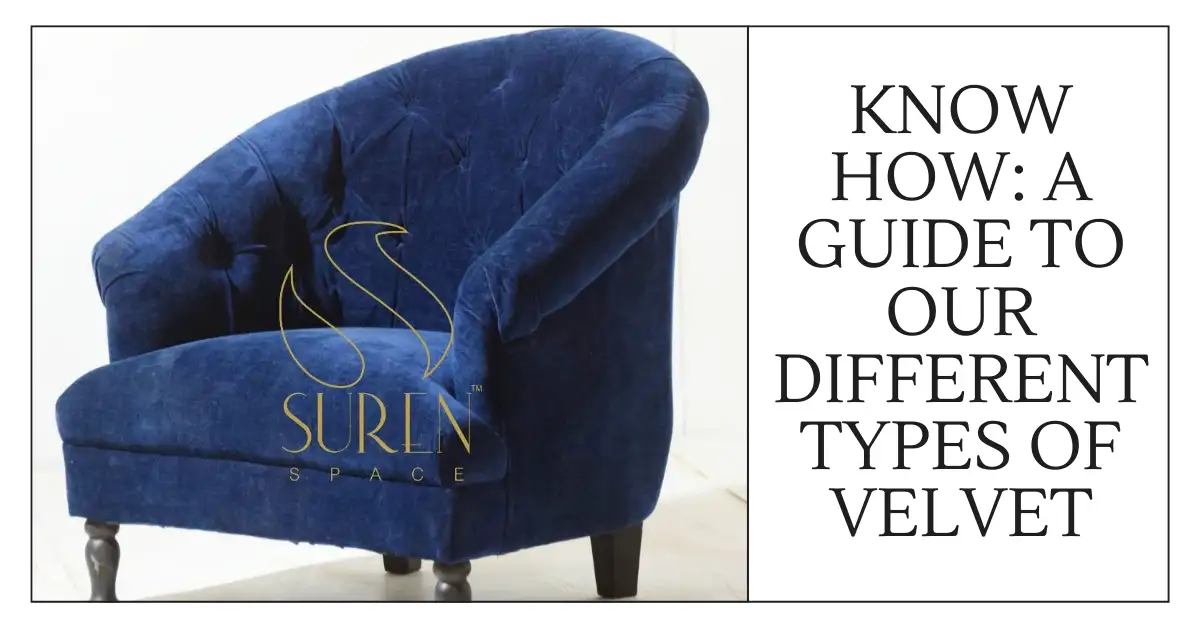Know How: A Guide to our Different Types of Velvet

Know How: A Guide to our Different Types of Velvet
Velvet can be defined as a luxurious soft expensive fabric considered exotic and used by the royalty. A fabric that is well recognized for its soft, glossy, vein like appearance, is often applied to endue furniture with a classic and shine. If you wish your home to appear as an actual lord’s residence or a star’s abode, then it is time for this fabric!
Having said that, there are a lot of variations to the type of velvet that you can incorporate in your home. If you need to get the texture and appearance that the upholstery fabric provides, then it will be wise to grasp more info on the kinds of velvet upholstery fabric in the market and their downsides.
What Is Velvet?
Velvet is a fine-grained luxurious textile material that was originally produced from silk, cotton, linen and mohair. It is one of fabrics with cut piles placed in tufted manner with even distribution of cut piles whereby the pile height is thick but of short nature ensuring that it is soft to touch. It was formerly restricted to the royal family because its manufacture required advanced looms that were very expensive to acquire; as the technology in looms advanced, the material started to be used by the numerous masses.
VISIT FOR :: restaurant counter
Types of Velvet
Wait till you listen to the different types of velvet that are available in the market these days! Velvet is available in dozens of forms with different material, weave, color, pattern, and even different kinds of faux velvet. Here in this guide on different types of velvet upholstery fabric we have reviewed only 11 of them. This is not all the types of velvet that are available but there are more and these categories are mostly used in making clothes than furniture.
Crushed Velvet
Crushed velvet has a look of being ‘crushed,’ or wrinkled, this is caused by the process of twisting the velvet material as it is wet or by the process of pressing the pile in two over different directions. This type of velvet is intensely shiny and has a luxurious royal touch to the feel of the fabric. It is mainly applied on fabricating curtains or making a pillowcase.
Embossed Velvet
Embossed velvet has patterns, which are produced by heat stamps. The patterns or tendencies lie in metallic or used to decline other colors; anyway, these bring aesthetic sense and texture to the fabric. This kind of velvet is used frequently in home upholstery since it is convenient to work on and it has the most original appearance.
Cisele Velvet
To make cisele fabric, you cut into the pile to make it from the various sizes of loops. This will cause the velvet to be smooth in certain regions and elevated in other regions, thereby making it have a surface with some sort of tiny protuberances and dents that result in a tough surface. The grosse couture employs cisele velvet in various types of furniture and on wall hangings in the form of tapestries. If you want a more defined and theatrical style then yes, it is recommended using it.
Plush Velvet
Plush velvet has long fibers and is extremely soft due to the long pile that is used in it. Other fabric lovers frown at plaza velvet for its excessively long pile saying that it is not a real velvet yet you will struggle to differentiate it from actual plush velvet. This is an excellent material to create soft and warm blankets and comforters since the fabric is soft and luxurious.
Stretch Velvet
Depending on which aspect of ‘stretch’ you desire, this type of velvet is both stretchable and flexible in usage. Stretch velvet is then stitched using stretch needle and stretch stitch and sometimes have spandex fibers in them. This kind of velvet is suitable for large, bulky or irregular pieces of furniture or for pieces that are fairly tender.
VISIT FOR :: sofa colour combination
Pile On Pile Velvet
It is a very widespread type of velvet production, in which the arrangement of the pile is different in thickness. Such different heaps form an outstanding pattern within the texture.
A Step by Step Guide on Cleaning Velvet Furniture
Velvet is a splendid and diverse fabric for furniture but do not underestimate how much care it needs! Unfortunately, if proper care is not taken when handling velvet then the fabric can mat, pile, tuft or shrink. Well, knowing how to look after velvet without damaging it is no mean feat, so how do you look after it? Some general rules to follow during handling include: Some general rules to follow during handling include:
If it’s wet velvet you should never apply pressure to it other than on crushed velvet in which you apply gentle pressure to help the material set.
- Allow to dry in a well aired room ideally with a temperature of about 27 degrees Celsius.
- Never iron but instead steam your clothes to reduce the wrap.
- To remove stains, remove moisture and let the item dry naturally.
- Always wash with cool water and a mild velvet-safe soap; it is advisable to never use harsh detergents on the item
- Do not expose to direct sunlight
In the end,
Velvet curtains are not only used for the purpose of privacy but also act as sound and light proof to the room. These are normally applied in living rooms; bedrooms and theaters since they make the environment warm and dramatic.
READ MORE :: Top 10 Wine Bar and Restaurant Furniture Brands

